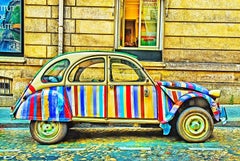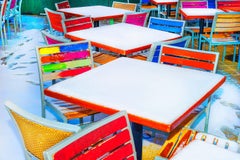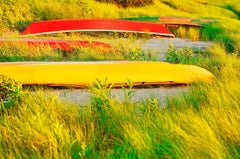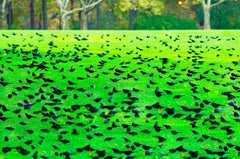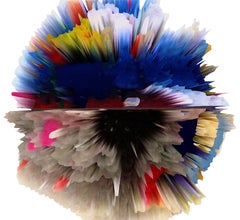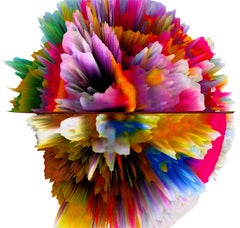Color-Field Art
to
48
67
21
54
56
112
Overall Width
to
Overall Height
to
152
157
1
1
3
25
48
25
29
115,150
65,103
54,336
26,943
14,901
9,120
6,240
5,741
4,186
3,051
2,598
2,299
2,225
717
131
97
77
19
17
15
13
10
9
9
6
6
6
5
5
4
4
4
4
3
3
3
3
199
97
97
94
94
28
26
20
13
9
71
34
234
44
Style: Color-Field
Funky Car Paris
Located in Miami, FL
Signed and dated on lower right, numbered on verso, 3/15 , other size available, unframed
Category
Early 2000s Color-Field Art
Materials
Photographic Paper
Colored Tables in the Snow
Located in Miami, FL
Signed and dated on lower right, numbered on verso, 3/15 , other size available, unframed
Category
2010s Color-Field Art
Materials
Photographic Paper
East Hampton Color
Located in Miami, FL
Inverted sailboats at Louse Point beach become bands of horizontal color in the beautiful study of summer.
Dr. Toby Israel discusses scenes of nature that you can project yourself ...
Category
Early 2000s Color-Field Art
Materials
Photographic Paper
Field of Birds
Located in Miami, FL
Signed and dated on lower right, numbered on verso, 3/15 Printed later, other size available, unframed
Category
2010s Color-Field Art
Materials
Photographic Paper
Chorioferol mRNA (white) (Pop Art, Street Art, Urban Art)
By Agent X
Located in Kansas City, MO
Agent X
Chorioferol mRNA (white) (Pop Art, Street Art, Urban Art)
Digital Print on Archival Paper
Year: 2021
Edition: 70
Size: 35 x 35 inch
Signed
COA provided (gallery issued)
Ref.:...
Category
2010s Color-Field Art
Materials
Archival Paper, Digital
Price Upon Request
Alfuderm mRNA (white) (Pop Art, Street Art, Urban Art)
By Agent X
Located in Kansas City, MO
Agent X
Alfuderm mRNA (white) (Pop Art, Street Art, Urban Art)
Digital Print on Archival Paper
Year: 2021
Edition: 70
Size: 37 x 35 inches
Signed
COA provided
Ref.: 924802-854
-----...
Category
2010s Color-Field Art
Materials
Archival Paper, Digital
Price Upon Request
Residential Beauty Series No.4 Grimes, Iowa
By David Pugh
Located in Kansas City, MO
Artist : David K. Pugh
Title : Residential Beauty Series No.4 Grimes, Iowa
Materials : Archival Pigment Print
Date : 2019
David has been a photographer for 10 years. After having p...
Category
2010s Color-Field Art
Materials
Photographic Paper, Archival Pigment
Price Upon Request
Pattern Series No.1
By David Pugh
Located in Kansas City, MO
Artist : David K. Pugh
Title : Pattern Series No.1
Materials : Archival Pigment Print
Date : 2019
David has been a photographer for 10 years. After having photographed a magnolia t...
Category
2010s Color-Field Art
Materials
Photographic Paper, Archival Pigment
Price Upon Request
Pattern Series No.2
By David Pugh
Located in Kansas City, MO
Artist : David K. Pugh
Title : Pattern Series No.2
Materials : Archival Pigment Print
Date : 2019
David has been a photographer for 10 years. After having photographed a magnolia t...
Category
2010s Color-Field Art
Materials
Photographic Paper, Archival Pigment
Price Upon Request
Memoire of a Moment
Located in White Plains, NY
Memoire of a Moment by Stanley Boxer, 1996. Oil and mixed media on canvas, 50.5 x 60.5 inches. This mixed media work has an active surface that is thickly painted, with defined brush...
Category
1990s Color-Field Art
Materials
Canvas, Mixed Media
Price Upon Request
Color-field art for sale on 1stDibs.
Find a wide variety of authentic Color-Field art available for sale on 1stDibs. Works in this style were very popular during the 21st Century and Contemporary, but contemporary artists have continued to produce works inspired by this movement. If you’re looking to add art created in this style to introduce contrast in an otherwise neutral space in your home, the works available on 1stDibs include elements of blue, red, purple, orange and other colors. Many Pop art paintings were created by popular artists on 1stDibs, including Mala Breuer, Mitchell Funk, Wolf Kahn, and Anne Russinof. Frequently made by artists working with Paint, and Fabric and other materials, all of these pieces for sale are unique and have attracted attention over the years. Not every interior allows for large Color-Field art, so small editions measuring 5.5 inches across are also available. Prices for art made by famous or emerging artists can differ depending on medium, time period and other attributes. On 1stDibs, the price for these items starts at $350 and tops out at $295,000, while the average work sells for $5,000.
Recently Viewed
View AllMore Ways To Browse
Maggie Siner
Maplethorpe Calla
Marble Woman Head
Marcel Leprin
Mark Stock
Martin Hardie
Mauritz Lindstrom
Maximillien Luce
Michael Budden Central Park
Midcentury Matador Paintings
Mike Wright
Miracle On Ice
Mississippi River Painting
Monarch Of The Glen Painting
Moroccan Paintings Essaouira
Morpho Butterfly Art
Mount Tamalpais
Murray Dessner
